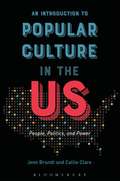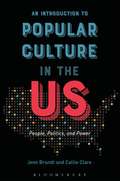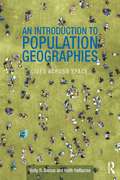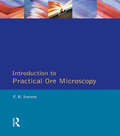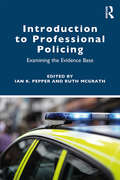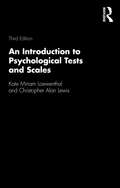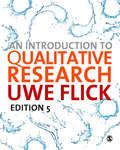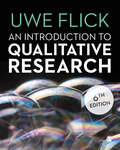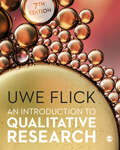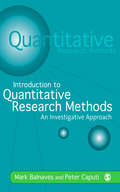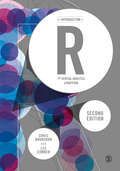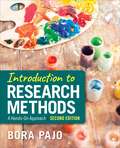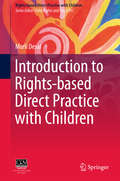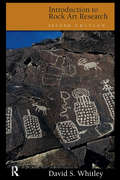- Table View
- List View
An Introduction to Political Geography: Space, Place and Politics
by Martin Jones Rhys Jones Michael Woods Mark Whitehead Deborah Dixon Matthew HannahAn Introduction to Political Geography continues to provide a broad-based introduction to contemporary political geography for students following undergraduate degree courses in geography and related subjects. The text explores the full breadth of contemporary political geography, covering not only traditional concerns such as the state, geopolitics, electoral geography and nationalism; but also increasing important areas at the cutting-edge of political geography research including globalization, the geographies of regulation and governance, geographies of policy formulation and delivery, and themes at the intersection of political and cultural geography, including the politics of place consumption, landscapes of power, citizenship, identity politics and geographies of mobilization and resistance. This second edition builds on the strengths of the first. The main changes and enhancements are: four new chapters on: political geographies of globalization, geographies of empire, political geography and the environment and geopolitics and critical geopolitics significant updating and revision of the existing chapters to discuss key developments, drawing on recent academic contributions and political events new case studies, drawing on an increasing number of international and global examples additional boxes for key concepts and an enlarged glossary. As with the first edition, extensive use is made of case study examples, illustrations, explanatory boxes, guides to further reading and a glossary of key terms to present the material in an easily accessible manner. Through employment of these techniques this book introduces students to contributions from a range of social and political theories in the context of empirical case study examples. By providing a basic introduction to such concepts and pointing to pathways into more specialist material, this book serves both as a core text for first- and second- year courses in political geography, and as a resource alongside supplementary textbooks for more specialist third year courses.
An Introduction to Popular Culture in the US: People, Politics, and Power
by Jenn Brandt Callie ClareWhat is popular culture? Why study popular culture in an academic context? An Introduction to U.S. Popular Culture: People, Politics, and Power introduces and explores the history and contemporary analysis of popular culture in the United States. In situating popular culture as lived experience through the activities, objects, and distractions of everyday life, the authors work to broaden the understanding of culture beyond a focus solely on media texts, taking an interdisciplinary approach to analyze American culture, its rituals, beliefs, and the objects that shape its existence. After building a foundation of the history of popular culture as an academic discipline, the book looks broadly at cultural myths and the institutional structures, genres, industries, and people that shape the mindset of popular culture in the United States. It then becomes more focused with an examination of identity, exploring the ways in which these myths and mindset are internalized, practiced, and shaped by individuals. The book concludes by connecting the broad understanding of popular culture and the unique individual experience with chapters dedicated to the objects, communities, and celebrations of everyday life. This approach to the field of study explores all matters of culture in a way that is accessible and relevant to individuals in and outside of the classroom.
An Introduction to Popular Culture in the US: People, Politics, and Power
by Jenn Brandt Callie ClareWhat is popular culture? Why study popular culture in an academic context? An Introduction to U.S. Popular Culture: People, Politics, and Power introduces and explores the history and contemporary analysis of popular culture in the United States. In situating popular culture as lived experience through the activities, objects, and distractions of everyday life, the authors work to broaden the understanding of culture beyond a focus solely on media texts, taking an interdisciplinary approach to analyze American culture, its rituals, beliefs, and the objects that shape its existence. After building a foundation of the history of popular culture as an academic discipline, the book looks broadly at cultural myths and the institutional structures, genres, industries, and people that shape the mindset of popular culture in the United States. It then becomes more focused with an examination of identity, exploring the ways in which these myths and mindset are internalized, practiced, and shaped by individuals. The book concludes by connecting the broad understanding of popular culture and the unique individual experience with chapters dedicated to the objects, communities, and celebrations of everyday life. This approach to the field of study explores all matters of culture in a way that is accessible and relevant to individuals in and outside of the classroom.
An Introduction to Population Geographies: Lives Across Space
by Holly R. Barcus Keith HalfacreeAn Introduction to Population Geographies provides a foundation to the incredibly diverse, topical and interesting field of twenty-first-century population geography. It establishes the substantive concerns of the subdiscipline, acknowledges the sheer diversity of its approaches, key concepts and theories and engages with the resulting major areas of academic debate that stem from this richness. Written in an accessible style and assuming little prior knowledge of topics covered, yet drawing on a wide range of diverse academic literature, the book’s particular originality comes from its extended definition of population geography that locates it firmly within the multiple geographies of the life course. Consequently, issues such as childhood and adulthood, family dynamics, ageing, everyday mobilities, morbidity and differential ability assume a prominent place alongside the classic population geography triumvirate of births, migrations and deaths. This broader framing of the field allows the book to address more holistically aspects of lives across space often provided little attention in current textbooks. Particular note is given to how these lives are shaped though hybrid social, biological and individual arenas of differential life course experience. By engaging with traditional quantitative perspectives and newer qualitative insights, the authors engage students from the quantitative macro scale of population to the micro individual scale. Aimed at higher-level undergraduate and graduate students, this introductory text provides a well-developed pedagogy, including case studies that illustrate theory, concepts and issues.
An Introduction to Population Geographies: Lives Across Space
by Holly R. Barcus Keith HalfacreeAn Introduction to Population Geographies provides a foundation to the incredibly diverse, topical and interesting field of twenty-first-century population geography. It establishes the substantive concerns of the subdiscipline, acknowledges the sheer diversity of its approaches, key concepts and theories and engages with the resulting major areas of academic debate that stem from this richness. Written in an accessible style and assuming little prior knowledge of topics covered, yet drawing on a wide range of diverse academic literature, the book’s particular originality comes from its extended definition of population geography that locates it firmly within the multiple geographies of the life course. Consequently, issues such as childhood and adulthood, family dynamics, ageing, everyday mobilities, morbidity and differential ability assume a prominent place alongside the classic population geography triumvirate of births, migrations and deaths. This broader framing of the field allows the book to address more holistically aspects of lives across space often provided little attention in current textbooks. Particular note is given to how these lives are shaped though hybrid social, biological and individual arenas of differential life course experience. By engaging with traditional quantitative perspectives and newer qualitative insights, the authors engage students from the quantitative macro scale of population to the micro individual scale. Aimed at higher-level undergraduate and graduate students, this introductory text provides a well-developed pedagogy, including case studies that illustrate theory, concepts and issues.
Introduction to Practical Ore Microscopy
by P. R. InesonFirst published in 1989. Routledge is an imprint of Taylor & Francis, an informa company.
Introduction to Practical Ore Microscopy
by P. R. InesonFirst published in 1989. Routledge is an imprint of Taylor & Francis, an informa company.
Introduction to Professional Policing: Examining the Evidence Base
by Ruth McGrath Ian K. PepperPolicing is a dynamic profession with increasing demands and complexities placed upon the police officers and staff who provide a 24-hour service across a diverse range of communities. Written by experts in police higher education from across both academic and professional practice, this book equips aspiring or newly appointed police constables with the knowledge and understanding to deal with the significant and often complex challenges they face daily. Introduction to Professional Policing explores a selected number of the core underpinning knowledge requirements identified as themes within the evolving National Policing Curriculum (NPC) and Police Education Qualifications Framework (PEQF). These include: The evolution of criminal justice as a discipline Exploration of operational duties The ethics of professional policing Victims and protection of the vulnerable Crime prevention and approaches to counter-terrorism Digital policing and data protection Evidence based decision making Police leadership At the end of each chapter the student finds a case study, reflective questions and a further reading list, all of which reinforces students’ knowledge and furthers their professional development. Written in a clear and direct style, this book supports aspiring police constables, newly appointed police constables or direct entry (DE) detectives, as well as those interested in learning more about policing. It is essential reading for students taking a degree in Professional Policing.
Introduction to Professional Policing: Examining the Evidence Base
by Ruth McGrath Ian K. PepperPolicing is a dynamic profession with increasing demands and complexities placed upon the police officers and staff who provide a 24-hour service across a diverse range of communities. Written by experts in police higher education from across both academic and professional practice, this book equips aspiring or newly appointed police constables with the knowledge and understanding to deal with the significant and often complex challenges they face daily. Introduction to Professional Policing explores a selected number of the core underpinning knowledge requirements identified as themes within the evolving National Policing Curriculum (NPC) and Police Education Qualifications Framework (PEQF). These include: The evolution of criminal justice as a discipline Exploration of operational duties The ethics of professional policing Victims and protection of the vulnerable Crime prevention and approaches to counter-terrorism Digital policing and data protection Evidence based decision making Police leadership At the end of each chapter the student finds a case study, reflective questions and a further reading list, all of which reinforces students’ knowledge and furthers their professional development. Written in a clear and direct style, this book supports aspiring police constables, newly appointed police constables or direct entry (DE) detectives, as well as those interested in learning more about policing. It is essential reading for students taking a degree in Professional Policing.
An Introduction to Psychological Tests and Scales
by Kate Miriam Loewenthal Christopher Alan LewisThis text is a vital resource for those with little or no prior knowledge of computing or statistics to aid in the development of reliable and valid tests and scales for assessment or research purposes. It serves as a clear, concise and jargon-free primer for all those embarking in fieldwork or research analysis. The book contains detailed guidelines for locating and constructing psychological measures, including descriptions of popular psychological measures and step-by-step instructions for composing a measure, entering data, and computing reliability and validity of test results. Advanced techniques such as factor analysis, analysis of covariance, and multiple regression analysis are presented for the beginner. This new edition has been revised throughout and includes updated statistical test procedures in line with the new version of SPSS and the inclusion of current academic articles. It serves as an invaluable resource for undergraduates and postgraduates across the behavioral and social sciences, as well as professionals in related disciplines, including those working in management and medical sciences.
An Introduction to Psychological Tests and Scales
by Kate Miriam Loewenthal Christopher Alan LewisThis text is a vital resource for those with little or no prior knowledge of computing or statistics to aid in the development of reliable and valid tests and scales for assessment or research purposes. It serves as a clear, concise and jargon-free primer for all those embarking in fieldwork or research analysis. The book contains detailed guidelines for locating and constructing psychological measures, including descriptions of popular psychological measures and step-by-step instructions for composing a measure, entering data, and computing reliability and validity of test results. Advanced techniques such as factor analysis, analysis of covariance, and multiple regression analysis are presented for the beginner. This new edition has been revised throughout and includes updated statistical test procedures in line with the new version of SPSS and the inclusion of current academic articles. It serves as an invaluable resource for undergraduates and postgraduates across the behavioral and social sciences, as well as professionals in related disciplines, including those working in management and medical sciences.
An Introduction to Qualitative Research
by Dr Uwe FlickLecturers - request an e-inspection copy of this text or contact your local SAGE representative to discuss your course needs. In the new edition of his bestselling book, Uwe Flick introduces all of the main theoretical approaches to qualitative research, and provides unmatched coverage of the full range of methods now available to qualitative researchers. Organised around the process of doing qualitative research, the book guides you through ethics, research design, data collection, and data analysis. In this fifth edition, you will find: a new chapter outlining methodological approaches to qualitative research new introductory sections at the beginning of each of the book’s seven parts, which prepare the ground and define key terms lots of new practical examples which show you how to carry out all aspects of a qualitative research project new exercises that give you the opportunity to test your understanding of what you’ve read a brand new companion website full of resources for lecturers and students including suggested answers to the exercises in the book, full text journal articles and links to additional resources: http://uk.sagepub.com/flick5e Available with Perusall—an eBook that makes it easier to prepare for class Perusall is an award-winning eBook platform featuring social annotation tools that allow students and instructors to collaboratively mark up and discuss their SAGE textbook. Backed by research and supported by technological innovations developed at Harvard University, this process of learning through collaborative annotation keeps your students engaged and makes teaching easier and more effective. Learn more.
An Introduction to Qualitative Research
by Dr Uwe FlickLecturers - request an e-inspection copy of this text or contact your local SAGE representative to discuss your course needs. In the new edition of his bestselling book, Uwe Flick introduces all of the main theoretical approaches to qualitative research, and provides unmatched coverage of the full range of methods now available to qualitative researchers. Organised around the process of doing qualitative research, the book guides you through ethics, research design, data collection, and data analysis. In this fifth edition, you will find: a new chapter outlining methodological approaches to qualitative research new introductory sections at the beginning of each of the book’s seven parts, which prepare the ground and define key terms lots of new practical examples which show you how to carry out all aspects of a qualitative research project new exercises that give you the opportunity to test your understanding of what you’ve read a brand new companion website full of resources for lecturers and students including suggested answers to the exercises in the book, full text journal articles and links to additional resources: http://uk.sagepub.com/flick5e Available with Perusall—an eBook that makes it easier to prepare for class Perusall is an award-winning eBook platform featuring social annotation tools that allow students and instructors to collaboratively mark up and discuss their SAGE textbook. Backed by research and supported by technological innovations developed at Harvard University, this process of learning through collaborative annotation keeps your students engaged and makes teaching easier and more effective. Learn more.
An Introduction to Qualitative Research
by Dr Uwe FlickThe definitive guide to the full qualitative research process, from design to dissemination, this is everything you need to understand how good quality research is produced, and how to use and enrich your own work with it. New to this edition: - A new structure follows the research process step-by-step - Brand new chapter on digital methods and social media data explores cutting-edge research - Multi-disciplinary case studies give you real research examples whatever your subject - Focused reading exercises help you explore the literature and build a better bibliography - Integrated online resources, to master the key concepts, discover real research and track your progress An Introduction to Qualitative Research has everything a social science student needs to understand and explore the richness of qualitative research.
An Introduction to Qualitative Research
by Dr Uwe FlickThe definitive guide to the full qualitative research process, from design to dissemination, this is everything you need to understand how good quality research is produced, and how to use and enrich your own work with it. New to this edition: - A new structure follows the research process step-by-step - Brand new chapter on digital methods and social media data explores cutting-edge research - Multi-disciplinary case studies give you real research examples whatever your subject - Focused reading exercises help you explore the literature and build a better bibliography - Integrated online resources, to master the key concepts, discover real research and track your progress An Introduction to Qualitative Research has everything a social science student needs to understand and explore the richness of qualitative research.
An Introduction to Qualitative Research
by Uwe FlickContinuing to be THE guide to the whole qualitative research process for students, this book looks at both the theory behind qualitative research and how to put it into practice in your own work. For students across a range of social science disciplines and beyond, this is a must to help you enhance your research project. This edition introduces: a decolonisation of methodologies a range of indigenous, queer and feminist perspectives on methodologies assistance with defending a viva and alternative forms of assessment to suit a changing world. More additions to this seventh edition include a section on the subjectivity of a researcher, and how your identity will shape your research. The further reading has been curated to include more than just western voices, providing you with global perspectives on qualitative research. This text introduces how to sensitively undertake ethical and inclusive research with marginalised groups. This book will help you master a comprehensive understanding of qualitative research.
An Introduction to Qualitative Research
by Uwe FlickContinuing to be THE guide to the whole qualitative research process for students, this book looks at both the theory behind qualitative research and how to put it into practice in your own work. For students across a range of social science disciplines and beyond, this is a must to help you enhance your research project. This edition introduces: a decolonisation of methodologies a range of indigenous, queer and feminist perspectives on methodologies assistance with defending a viva and alternative forms of assessment to suit a changing world. More additions to this seventh edition include a section on the subjectivity of a researcher, and how your identity will shape your research. The further reading has been curated to include more than just western voices, providing you with global perspectives on qualitative research. This text introduces how to sensitively undertake ethical and inclusive research with marginalised groups. This book will help you master a comprehensive understanding of qualitative research.
An Introduction to Qualitative Research
by Uwe FlickContinuing to be THE guide to the whole qualitative research process for students, this book looks at both the theory behind qualitative research and how to put it into practice in your own work. For students across a range of social science disciplines and beyond, this is a must to help you enhance your research project. This edition introduces: a decolonisation of methodologies a range of indigenous, queer and feminist perspectives on methodologies assistance with defending a viva and alternative forms of assessment to suit a changing world. More additions to this seventh edition include a section on the subjectivity of a researcher, and how your identity will shape your research. The further reading has been curated to include more than just western voices, providing you with global perspectives on qualitative research. This text introduces how to sensitively undertake ethical and inclusive research with marginalised groups. This book will help you master a comprehensive understanding of qualitative research.
Introduction to Quantitative Research Methods: An Investigative Approach
by Peter Caputi Mark BalnavesIntroduction to Quantitative Research Methods is a student-friendly introduction to quantitative research methods and basic statistics. It uses a detective theme throughout the text to show how quantitative methods have been used to solve real-life problems. The book focuses on principles and techniques that are appropriate to introductory level courses in media, psychology and sociology. Examples and illustrations are drawn from historical and contemporary research in the social sciences. The original CD-ROM accompanying the book and its content are no longer available.
Introduction to Quantitative Research Methods: An Investigative Approach
by Peter Caputi Mark BalnavesIntroduction to Quantitative Research Methods is a student-friendly introduction to quantitative research methods and basic statistics. It uses a detective theme throughout the text to show how quantitative methods have been used to solve real-life problems. The book focuses on principles and techniques that are appropriate to introductory level courses in media, psychology and sociology. Examples and illustrations are drawn from historical and contemporary research in the social sciences. The original CD-ROM accompanying the book and its content are no longer available.
An Introduction to R for Spatial Analysis and Mapping (Spatial Analytics and GIS)
by Chris Brunsdon Lex ComberThis is a new edition of the accessible and student-friendly 'how to' for anyone using R for the first time, for use in spatial statistical analysis, geocomputation and digital mapping. The authors, once again, take readers from ‘zero to hero’, updating the now standard text to further enable practical R applications in GIS, spatial analyses, spatial statistics, web-scraping and more. Revised and updated, each chapter includes: example data and commands to explore hands-on; scripts and coding to exemplify specific functionality; self-contained exercises for students to work through; embedded code within the descriptive text. The new edition includes detailed discussion of new and emerging packages within R like sf, ggplot, tmap, making it the go to introduction for all researchers collecting and using data with location attached. This is the introduction to the use of R for spatial statistical analysis, geocomputation, and GIS for all researchers - regardless of discipline - collecting and using data with location attached.
An Introduction to R for Spatial Analysis and Mapping (Spatial Analytics and GIS)
by Chris Brunsdon Lex ComberThis is a new edition of the accessible and student-friendly 'how to' for anyone using R for the first time, for use in spatial statistical analysis, geocomputation and digital mapping. The authors, once again, take readers from ‘zero to hero’, updating the now standard text to further enable practical R applications in GIS, spatial analyses, spatial statistics, web-scraping and more. Revised and updated, each chapter includes: example data and commands to explore hands-on; scripts and coding to exemplify specific functionality; self-contained exercises for students to work through; embedded code within the descriptive text. The new edition includes detailed discussion of new and emerging packages within R like sf, ggplot, tmap, making it the go to introduction for all researchers collecting and using data with location attached. This is the introduction to the use of R for spatial statistical analysis, geocomputation, and GIS for all researchers - regardless of discipline - collecting and using data with location attached.
Introduction To Research Methods: A Hands-on Approach (PDF)
by Bora PajoThe Second Edition of Introduction to Research Methods: A Hands-On Approach by Bora Pajo continues to make research easy to understand and easy to construct. Covering both quantitative and qualitative methods, this new edition lays out the differences between research approaches so readers can better understand when and how to use each research design. Through clear, simple, and even humorous prose, this text offers students a straightforward introduction to a new world of social science research. Rather than making research seem intimidating, Introduction to Research Methods shows students that research is an ongoing conversation concerning topics that matter in their lives, a conversation that′s easy to understand and easy to join. The new edition features updated chapters on qualitative designs and qualitative data analysis, a new chapter on big data and digital methods, and updated citation and report styles for APA Style 7th Edition.
Introduction to Rights-based Direct Practice with Children (Rights-based Direct Practice with Children)
by Murli DesaiThe Sourcebook introduces the theoretical and ideological foundation and methodological basis of Rights-based Direct Practice with Children. It starts with the methodology of participatory group workshops to facilitate learning of the content. The content draws linkages among the foundation of life skills; psychosocial, sociological and critical theories of childhood; and child rights values, categories and principles; with the approaches, methods and skills of direct practice with children. The book takes examples from India but makes significant contribution to training and reference material for child rights teachers, trainers, facilitators and field workers, across the world, especially in the developing countries.
Introduction to Rock Art Research
by David WhitleyFirst published in 2005, this brief introduction to methods of studying rock art has become the standard text for courses on this topic. It was also selected as a Choice Magazine Outstanding Academic Book in 2005. Internationally-known rock art researcher David Whitley takes the reader through the various processes needed to document, interpret, and preserve this fragile category of artifact. Using examples from around the globe, he offers a comprehensive guide to rock art studies of value to archaeologists and art historians, their students, and rock art aficionados. The second edition of this classic work has additional material on mapping sites, ethnographic analogy, neuropsychological models, and Native American consultation.

